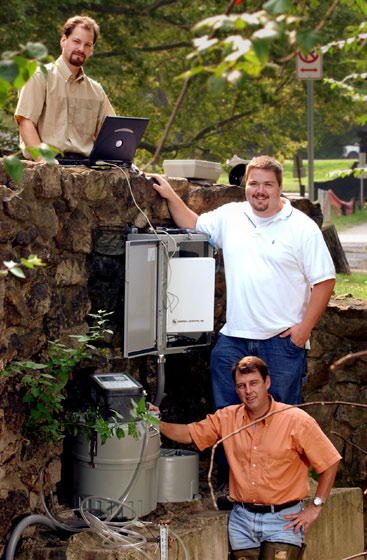Civil engineering major and Marquis Scholar James Mangarillo ’03 (Hampton Bays, N.Y.) is conducting two research projects this summer that focus on stream pollution. The projects are providing Mangarillo with an early sampling of the water-quality field and practical experience he will take to the real world after graduation.
Mangarillo is working as an EXCEL Scholar with David Brandes, assistant professor of civil and environmental engineering, to install data collection stations at several locations throughout the Bushkill Watershed. He is examining how different parts of the watershed respond to storms and analyzing how the water from a storm travels through the watershed and affects the composition of a stream.
The data collection equipment installed by Mangarillo and Brandes measures the depth, dirtiness, temperature, and conductivity, and the amount of dissolved materials in the water. Mangarillo analyzes the data and then uploads it on the Internet.
“I’m gaining valuable work experience, not only in terms of fieldwork, but also in terms of lab work,” says Mangarillo. “Typically, an engineer either works in the field, or in the lab. Here, I get to do both. I have also learned valuable people skills from talking to residents in the surrounding municipalities as well as those at the state level in order to get the information I need.”
Brandes says Mangarillo is “doing really well. He’s a hard worker.”
Mangarillo is also working with Arthur Kney, assistant professor of civil and environmental engineering, on a second research project studying non-point source pollution and its effect on water quality and biodiversity. Non-point source pollution is storm water and its contaminants.
“He’s interested in hydrology, so this should be a pretty valuable experience,” says Kney, who believes Mangarillo’s summer research will help him prepare for a senior honors thesis this fall.
Mangarillo’s contribution involves taking samples to analyze the pollution at various locations, including a parking lot, a highway, a residential site, and a mixed or “composite site.”
“My main task for this project is to take the manpower needed for fieldwork and use it for data analysis in the lab,” says Mangarillo, adding that he worked to develop an automated sampling network.
In addition, he says to understand the amount of water that enters the river during a storm, a researcher must know the size of the area that contributes water to the location.
“This was my second task for the project, to delineate the watersheds that contribute to each site, which involves looking at topographic maps and examining storm sewer networks,” says Mangarillo.
“I’m the type of person who doesn’t like to do the same thing over and over again, and these projects fit in with my personality very well,” he says. “I also enjoy working with both Professor Brandes and Professor Kney. They allow me room to experiment with different ideas that a job would not.
“Lafayette has enabled me to grow not only as a student, but as a person as well. The combination of strong academics and a vibrant social scene makes Lafayette a unique place to attend college.”
A graduate of Hampton Bays High School, Mangarillo is vice president of the student chapter of American Society of Civil Engineers and a member of Lafayette Activities Forum. He lives on the Creating Harmony and Necessary Social Equality (CHANCE) floor and volunteers at Tracy Elementary School.

David Brandes, assistant professor of civil and environmental engineering (top), James Mangarillo ’03, and Art Kney, assistant professor of civil and environmental engineering, study pollution in the Bushkill Creek.
